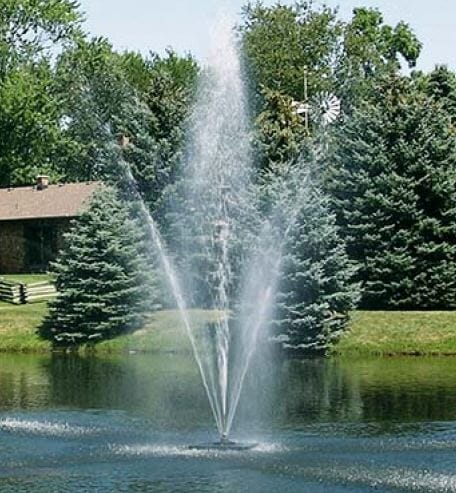An excellent investment for your home or property is installing a pond that looks right. The benefits are unquestionable. Some people chose for beauty, while others want their homes to have a relaxation point as a lifestyle goal. A fountain for your pond is an enjoyable asset as well. But it’s not only the beauty that they add but also the necessary aeration to keep your pond life heathy. This article focuses on the benefits of aeration for you pond.
Bacteria
Bacteria are all around us. They are necessary and good but can also be unhealthy and detrimental. When it comes to ponds, it is important to think about the differences between aerobic and anaerobic bacteria.
Anaerobic bacteria live in the unoxygenated parts of the pond. These bacteria digest unwanted organic debris but release a stinky gas. They also digest the unwanted debris more slowly than aerobic bacteria. Thus, plant material and fish wastes build up at the bottom of the pond and accumulate into muck. Your pond can soon become unhealthy.
Aerobic bacteria thrive in the oxygenated parts of the pond. These bacteria digest the unwanted organic debris faster than anaerobic bacteria and make for a much healthier pond. The pathway to a healthy pond and to keep it clearer is to circulate the layers of the pond and spread aerobic bacteria throughout.
Now there are two ways to do this: surface aeration and bottom aeration.
Surface aeration
A surface aerator consists of a pump suspended by a float on the surface of a pond. It can have a nozzle attached and form a nice pond fountain display. Or there can be no nozzle attached at all, which creates the most aeration, as there is nothing to obstruct the water flow (nozzles do restrict flow). You might have seen surface aerators without nozzles attached at sewer farms. There is no display other than an agitated surface bubbling.
Bottom aeration
You can also use bottom aeration, which consists of diffusers on the bottom of the pond into which air is pumped by a compressor located somewhere at the shoreline. There is no consistent rule of thumb about when diffusers are the best option. Some companies recommend that a diffuser system be used in ponds deeper than six feet; some recommend you only need a diffuser when the average depth is greater than eight feet. You can also combine diffusers with surface aerators if you wish to decorate your pond with a fountain and provide bottom aeration at the same time. Bottom aeration provides more aerobic bacteria to the deep parts of ponds, thus eating away at muck and preventing it from building up all over again.
An aerated pond is a happy pond
Aeration is important to prevent your pond from going into an anaerobic state. Aerobic bacteria thrive, which create a harmless gas as they eat away at unwanted pond debris. You don’t get the rotten egg smell. In addition, aeration mixes the warmer surface water with the colder, deeper water. As the water is churned, the temperature of the pond will be more consistent throughout. Algae will be decreased.
You Can Also Add Beneficial Bacteria
On top of aeration, you can add beneficial bacteria to your pond or tank to eliminate sludge and foul odors. There are several products on the market. Kasco Macro-Zyme contains a high concentration of facultative anaerobic bacteria that will rapidly reproduce and consume organic material in your pond or lake. It is easy to use and releases billions of beneficial bacteria & enzymes that work around the clock to clean, neutralize, and purify. Application is simple and it is SAFE for HUMANS., PLANTS, and ANIMALS.
Fish Need Oxygen
Just like us humans, fish need oxygen to survive; they just get their supplies underwater. Aeration keeps pumping fresh oxygen into the pond, preventing or decreasing the risk of fish kill, when a whole lot of fish die at the same time. Oxygen is dissolved more consistently throughout the pond, rather than in layers.

